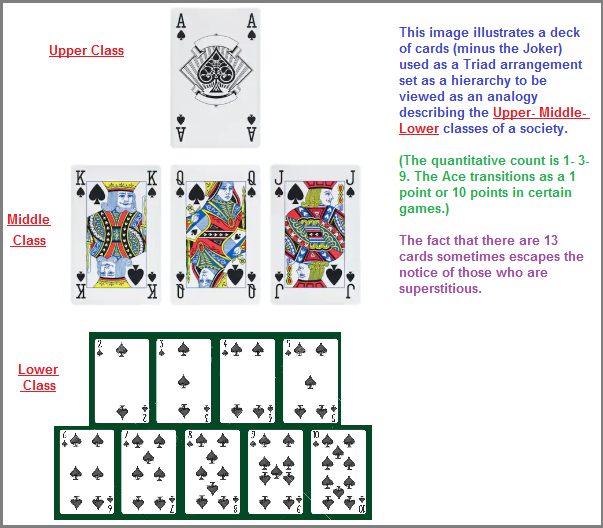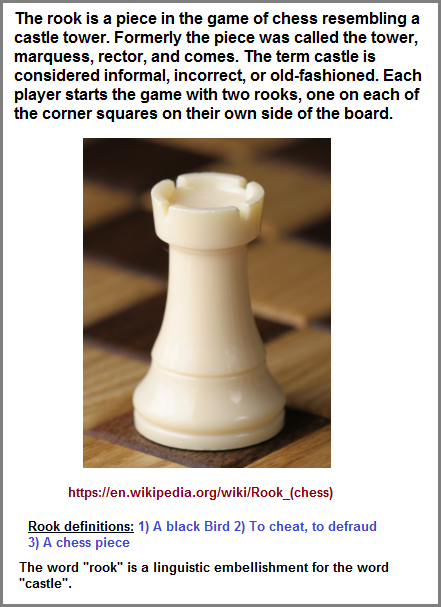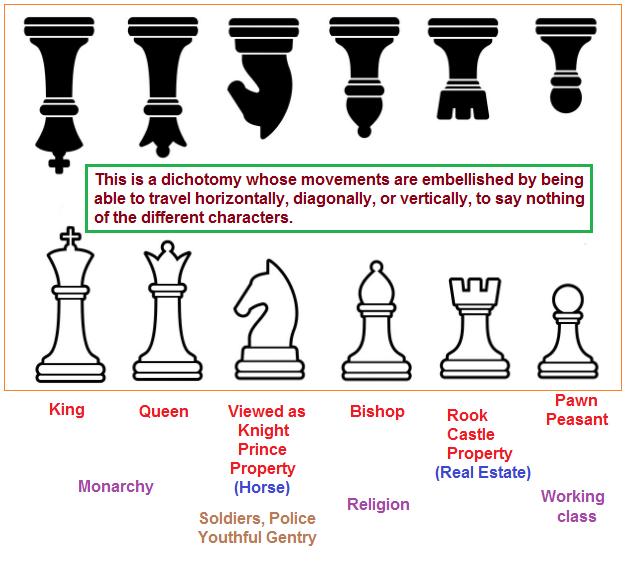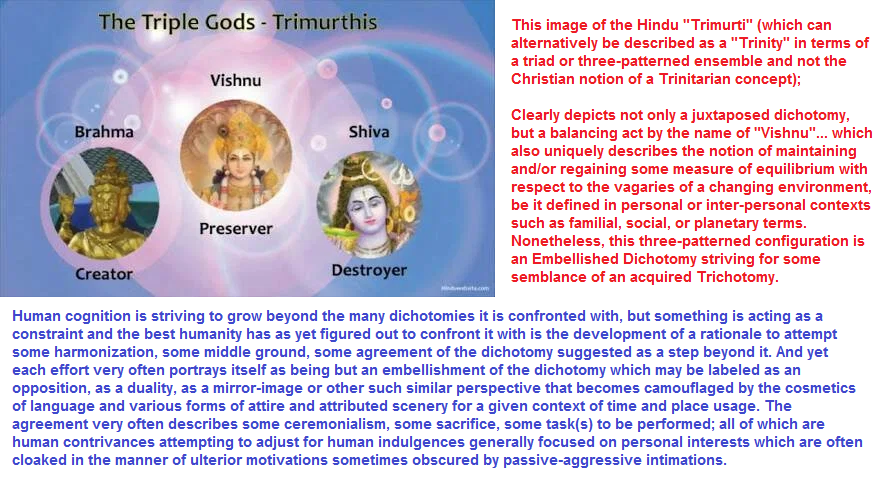pg 2
~ The Study of Threes ~
http://threesology.org
Researchers as of 12/16/2019
| Embellished Dichotomies Series | |||
| Page 1 | Page 2 | Page 3 | Page 4 |
Along the lines of discerning single, double and triple forms of embellishment, a list of numerically-oriented terms may be helpful. Please not the list is not definitive, yet is "top heavy" with "two"-related references:
The following is a list of idioms about multiplicative numbers (single, double, and triple) and their meanings: 50 Idioms with Single, Double, and Triple By Mark Nichol
- at a single blow/stroke: with one movement
- at/on the double: quickly
- body double: someone who stands in for another, especially in a performance
- double: two servings of an alcoholic beverage, a two-base hit in baseball, or an identical person or thing
- double as: serve in two capacities
- double back: return to a starting point
- double bill/feature: a performance involving two works or two performers or groups of performers; a separate meaning of "double bill" refers to being charged the cost of something twice
- double bind: a dilemma
- double booked: committed for two events, or scheduled for two people or parties at the same time
- double cross: an act of cheating or swindling
- double date: socialize as two couples, or the act of doing so
- double digits: the numbers 10 through 99
- double down: originally, double one's bet in blackjack; by extension, exert twice the effort
- double dribble: use both hands to bounce a basketball, or bounce a basketball again after stopping, or the act of committing either penalty
- double Dutch: a difficult language; also, a game of jump rope involving two ropes swung in different directions
- double duty: said in reference to something that serves two functions at once
- double entendre: a word or phrase with more than one meaning, one of which is obscene or sexual
- double in brass: see "double duty" (from a reference to a musician who performs on more than one instrument during a performance)
- double life: a life in which one assumes two identities
- double nickels: the number 55, often in reference to a speed limit (from the value of a nickel)
- double or nothing: a type of bet in which a person receives double the prize or nothing
- double over: bend over, as if in laughter or in pain
- double standard: principles or values hypocritically applied differently to different people or situations
- double take: a reaction in which one looks twice at something or someone because one is confused or surprised
- double talk: comments made to avoid telling the truth
- double tap: a repeated touch, or repeated firing of a weapon
- double time: move twice as fast, or cheat; as a noun, a rate of pay that is twice the normal rate, or a type of tempo in music
- double trouble: a difficult person or thing, or two difficult people or things
- double up: pair up or share; also, see "double over"
- double whammy: an occurrence of two bad things at a time
- double-bagger: a person considered so ugly that two nested grocery bags should be placed over the person's face to conceal it
- double-decker: a vehicle with two levels, or a two-layer sandwich
- double-dipper: one who earns two salaries or collects both Social Security payments and a federal pension; also, one scoops half-eaten finger food in a dip or sauce at the risk of introducing germs
- double-edged sword: something that might be advantageous but also dangerous
- double-tongued: deceitful or hypocritical
- doublespeak: deceitful or misleading language
- H-E-double-hockey-sticks/toothpicks: a euphemism for the oath hell, from the resemblance of the uppercase letter l to hockey sticks or the lowercase letter l to toothpicks
- of a single mind: in agreement
- see double: see two of everything, as when affected by dizziness
- single: an unmarried person, or a one-base hit in baseball
- single file: a reference to a line of people or things, with each one standing behind another
- single out: focus on or identify one thing
- triple: a set of three, or a three-base hit in baseball
- triple threat: someone talented in three areas
- triple whammy: see "double whammy"
- triple-bagger: see double-bagger
There appear to be no distinct separate entities when we observe typically used dichotomies, trichotomies, etc... All the presumed separate parts are inter-connected in some way, and that sometimes the inter-connections are so close that one or more is merely an embellishment of another or the others. However, the point in the idea of an "embellished dichotomy" is to shout out the presence of a dichotomy that is being displayed and claimed as a trichotomy, so that those claiming a dichotomy can not use their perception and interpretation as if it were a viable weapon to be used against those do not readily recognize the presence of a dichotomy but can be shown that such does in fact exist, whereby they react with embarrassment or self-imposed rejection for having held to the notion of an ideas as a trichotomy when it actually was not. In other words, there are those who would cite the presence of an "embellished dichotomy" against another's assertion for a trichotomy, without regard to the usage of being tactful. There is no need for someone to be antagonistic when citing the presence of a dichotomy being masqueraded as a trichotomy... or otherwise, since their use of a given dichotomy may be the result of using yet another dichotomy, whereby they are engaging in the usage of an "embellished dichotomy" themselves. A type of dichotomy within a dichotomy which may also be within a dichotomy, revealing a triad of dichotomies.
Playing the Devil's Advocate for my own research focus has helped in realizing that many of the "threes" I pay witness to are not as I had first thought them to be: Which is an "Actual Three", though I did not at the time even consider such a form of evaluation when I began to collect what has turned out to be a superficially aligned representation based on a simple count of three items, though this was later extended to included more than a single word, sentence, paragraph or longer and larger expression of a given singular topic.
There are varieties of the "three" which suggest to me a portrait of brain activity related to an underlying developmental theme that some have thought to express as a progression from some primitive state to a more advanced one; often passing through an intermediary that may or may not be thought of as a distinct entity— and not merely as a compromise, blend, extension or precursor formation from which an initial stage development occurs. For example, whereas we catalogue the three Germ layers as Endoderm- Mesoderm- Ectoderm, and may or may not acknowledge an overlap, others may or may not as well come to identify that the middle term (Mesoderm) actually occurred thirdly... or lastly, in evolutionary terms, whereby an earlier developmental stage reflected a two-part structure of Endoderm- Ectoderm, which some readers may want to consider as having had a period of earlier development where only one supposed Germ layer existed, from which is thought to have occurred the initial progression of the 1st, 2nd, and 3rd "stages", though the word and numerical designations are arbitrarily attributed constructs meant as personalized identifiers. At this time in my life I am reaching out for a greater sobriety of thought by being brutally honest and as critical of my own work as I can. I am pursuing such because I have been reminding myself of a poem that "popped" into my mind many decades ago, quite possibly after having read the poem by Emily Dickinson (1830-1886) : Because I could not stop for Death.
Here is the rather short poem which comes to mind that I jotted down years... decades ago:
Time passes by me, it is faster than I
onwards towards a destiny, that seems only to die
I did not set the pace, not that I remember
of this silent footrace, I had no choice to enter.
Whereas it is catalogued somewhere in one of my journals and may as well contain other lines, these are the ones which come to mind. They present me with some unspoken urgency to complete the illustration of impressions which at time fleet and flurry by that I must wake early and spend long moments in contemplation trying to unravel that which is impressed upon my brow from which I can glean only a bit into some attempted precipice of teetering expression. I feel as if I am on a ledge presently in a slight breeze, but that a gale force may come at any moment. However, in reflection, I know this to be one of those self-created "discomforting conditionals" that many creative-oriented individuals develop as the needed "inspirational irritant" from which a peal of an idea, song, artwork, or other motivation arises, since it has been variously documented that creativity requires one not to get too comfortable... though too much discomfort can be disabling.
Because I too had previously adopted a biological model of explication in attempting to both diagnose and catalogue what appeared to be a developmental theme represented by various three-patterned ensembles of ideas by different authors, I now consider that such a view may have been too hasty, though not completely wrong, since what the words suggest do not necessarily represent what actually occurs. The "Meso- derm" meaning middle, did not occur 2nd in order of development as is suggested by the lineup, but it does occur in the middle, as if Nature somehow thought it necessary to create an interlinking partition between two developmental scenarios that may have unknowingly been at each other's throats like siblings rivalries, though human consciousness could not perceive such an intimate occurrence from its presence outside the "familial" developmental setting which showed a different face while in the public viewing realm and its largely specious interpretation of activities.
Human ego very often gets in the way and imagines something more (or less) than that which preceded it— to suggest, like a child, that they are getting taller, can run faster, jump higher, getting smarter, etc... We sometimes create scenarios imagined to be tasks set before us to surmount, like some present video or old pinball game, if not some game of chance to win what is believed to be as a desirable reward. The same goes for ideas we create whose wording may be used to artificially construct the image of a progression, when all we have constructed is a word list suggesting a proposed architectural draft, as a projected image of a mindset striving for some semblance of that which provides the view we are (somehow) involved with a progression from less to more, lower to higher, dumbness to smartness, weak to strong, insignificant to important, etc...
That which we call a dichotomy or a trichotomy suggesting a progression could well be false, even though our actions are well-intentioned and do not want to mislead or falsely persuade for some maliciously contrived gain as the ulterior motive behind our efforts. Likewise, the usage of a singularity such as the word "god" or "utopia" or "perfection" could well be ego-tisically approximated desires for that which the words suggest by way of definition, though they are actually embellishments... a sort of "truth stretching" advertisement of our efforts. While they suggest some endpoint of desirable achievement or acquisition, they are merely the projections of a desire for such and not actually that which is named. Hence, the "One God" is not the ONE God, it is the desire for some image of a One God to be associated with and thus uniquely positioned with to acquire some imaginatively aligned reward... to be used as a means of persuasion that camouflages the deception which multiple others may come to believe in by way of a collective delusion and thus together set up a social order which creates both distractible ceremony, institutions and an hierarchically arrayed socialization which perpetuate the illusion, though many of its presumed adherents have come to see through the fog of the socialized delusion that future generations may well recognize and define as a collectively practiced neurosis, if not psychosis.
There are multiple three-term representations of ideas suggesting a progression such as:
- birth- life- death
- infant- child- adult
- one- two- three
- stop- wait- go
- low- medium- high
- virgin- mother- crone
- bronze- silver- gold
- 3rd place- 2nd place- 1st place
- Bachelor's- Master's- PhD
- grade C- grade B- grade A
- small- medium- fast
- slow- medium- fast
- X large- XX large XXX large
There are also three-part ensembles which do not readily suggest a progress, unless one looks at their history of development:
- Knife- Fork- Spoon
- Barefoot- Sandle- Shoe (and the "stages" between such as a foot simply wrapped in leaves, bark or cloth)
- Amphibians- Reptiles- Mammals
- Sumerian phonetization - West Semitic syllabary - Greek alphabet (3 great writing steps) BTR column 2
- Goldophin Barb- Byerly Turk- Darely Arabian (Although differently labeled elsewhere, these are the 3 ancestral sires of the racing stallion line)
- RNA- DNA- Proteins
The First Three Minutes of the Universe... a 1- 2- 3 scenario showing dichotomies. Astronomy 162: Professor Barbara Ryden
- During the first four seconds of the universe, matter formed by pair production. (dichotomy)
- After two minutes, deuterium formed by the fusion of protons and neutrons. (dichotomy)
- After three minutes, helium formed by the fusion of deuterium, protons, and neutrons. (trichotomy)
- Paleolithic Period or Old Stone Age (30,000 BCE–10,000 BCE)
- Mesolithic Period or Middle Stone Age (10,000 BCE–8,000 BCE)
- Neolithic Period or New Stone Age (8,000 BCE–3,000 BCE)
Sometimes, the three stages are characterized as Stone- Bronze- Iron, and at other times we find 3 Major Periods of Metal Age (Copper, Bronze, Iron; with Bronze being an amalgamation of tin and copper); though the stages may not be the same everywhere as discussed here: On the Supposed Stone, Bronze, and Iron Ages of Society
The period of the 3rd, the 2nd, and the 1st millennia BCE was a time of drastic change in Europe. This has traditionally been defined as the Metal Ages, which may be further divided into (three metal) stages, of approximate dates as shown:
- The Bronze Age (2300–700 BCE).
- The Copper Age (c. 3200–2300 BCE)
- The Iron Age (700–1 BCE)
Simultaneous with these technological innovations were changes in settlement organization, ritual life, and the interaction between the different societies in Europe. These developments and their remarkable reflections in the material culture make the period appear as a series of dramatic changes.
The three-age system is the periodization of history into time periods divisible by three; for example: the Stone Age, the Bronze Age, and the Iron Age; although it also refers to other tripartite divisions of historic time periods. In history, archaeology and physical anthropology, the three-age system is a methodological concept adopted during the 19th century by which artifacts and events of late prehistory and early history could be ordered into a recognizable chronology. It was initially developed by C. J. Thomsen, director of the Royal Museum of Nordic Antiquities, Copenhagen, as a means to classify the museum’s collections according to whether the artifacts were made of stone, bronze, or iron.
Let me admit that when I first began listing examples of "threes", I discounted and dismissed other patterns and selectively chose those examples containing a "three-part" authored representation over a non- three-part example, though different patterns were being used for the same material. Later on, in my striving to be more honest with myself and my recording since my self-deception would be found out later on by someone anyway; I began to collect the alternative patterns being used for the same information and decided that the human mind must be using a different set of brain modeling for the illustrations. Indeed, why was one person using a pattern-of-two, another a pattern-of-three and yet another person somehow seeing a different pattern altogether for the same information? Were they all right or all wrong, or was the information being looked at somehow incomplete and was somehow being formatted in a way so as to present a given author with their respective viewpoint? Was it the Big end/ Little end type of situation as outlined in the old Gulliver's travels stories with respect to Gulliver's journey to the land of Lilliput?
No less, when information, as it was presented referenced a pattern-of-two or some other-than-three pattern, why did a particular author use the other pattern? Because of some personal fondness for a given number or because they actually derived the pattern from the material? While there are instances where some writers will increase the volume or number in a display of adolescent-like one-up-man-ship, this did not appear to be the case in all instances. Yes, some did offer a "three-pattern" for a given example of information for which I at first was gratified to see, but then came to question my own motivations and decided that what I think I was seeing may be little more than the personalized embellishment of a dichotomy, though some embellish singularities, and other enumerated patterns are likewise embellished to give the impression of more... like a piece of chewy candy being stretched out, as if to increase some imagined tasty morsel... or food for thought.
I simply hated the notion that I may be engaging in what others might describe as an obsessive-compulsion, wherein I "read into" information with a deliberate attempt to see a pattern, even to the point of distorting information. Thus, I have come to a point in time where I must play the part of a Devil's Advocate to my own research efforts and record not only the presence of an assumed pattern-of-three, but the absence thereof, by cataloguing, in some instances, non-three patterns. I must also, to my discovered delight, record those instances which involve what appear to be three-patterned ensembles of different patterns such as the 2-3-4, as indicated here: The Devil's Advocate page 14. I would not have seen this recurring three-patterned ensemble if I had not begun to question my motivations and enlarge my sphere of enumerated examples from different subjects. This is not to say that embellishments are not occurring and that the discovery of this recurring pattern is not an act of embellishing my overall "threes" collecting efforts, but what a joy to find another type of threes examples "hidden" by a strangulation of perception which freed itself from the blinders it had on by adopting a more honest approach in my examinations.
Let me use another analogy in describing the notion of "Embellished Dichotomies" from a different perspective for those not interested in reading the volumes of commentary which can be associated with it, though this particular one may not appear too clear for some readers. Suffice it to say that when we see a trichotomy, or what may be termed an ensemble-of-three items such as the Jack- Queen- King trio of faces in a deck of playing cards, we might be inclined to accept this group as a 3-in-1 assemblage (3 face cards in one deck), but the idea of a dichotomy may not enter our mind. It does however enter our mind if we contrast the face cards with the numbered cards, or the numbered cards with the Ace card, though many card players do not contrast the face cards with the Ace, since it too is generally considered one of the "upper" class of valuable cards. However, one might (if prompted to do so): think of a three-part ensemble to be further associated with social stratification such as:
- The one Ace (representing THE upper class in a deck of cards viewed as a social organization).
- The three face cards (representing the Middle or even upper Middle class).
- The numbered cards (representing the Lower class).

Alternatively, in a manner of speaking, we can view the face cards as the "middle child" in this family arrangement, so long as the definition is meant as a loose approximation despite any hard-liner perception which might be evoked.
If we view the Ace and the Numbered cards as a dichotomy, then the three face cards are in a position of what may be termed an embellishment of the overall situation... a sort of mid-point, though the idea of transition and inter-mixing may not come to mind. In this example, the middle item(s) are to be contrasted with the other two, thus developing a dichotomy. Because of their status and regal overtures, they exhibit an embellishment of form and functionality.
Looking at the game of chess presents us with a more identifiable example of linguistic embellishment wherein the playing piece now called the "rook" (even though the word "rook" has an unwelcomed meaning in some instances); has been exchanged the word "castle" which is viewed as being too old fashioned. Perhaps the word "rook" is seen as a slang whereas the word "castle" is too obvious, too easy and thus like many things which come to acquire a slang term, something that needs to be recast for a later generation to adopt in order to stake a personal claim to it that a previous generation claimed as their's by having an accepted name for it... which then tells us nothing about why there is an established attitude amongst educational institutions on the elementary, Jr. High and High school levels in the U.S. that don't permit the young to alter, at the very least, the nickname and identifying school mascot for their separate senior years.

In the same manner of asking someone to devise a three-patterned sociological arrangement of playing cards we do so with chess pieces, we might first want to categorize the pieces in the following manner, noting the overall embellishment of a dichotomy embellished by having the various characterizations of the dichotomy be able to move in a horizontal, diagonal and/or vertical orientation:

Speaking on the Topic of "Embellished Dichotomies" as a separate and very important issue for those having a realization of the extent to which many researchers use a pattern-of-three in their ideas, whether or not they are actually conscious that they are using a pattern that others have used as well; rightly needs its own page, though this "page" will necessarily need the word to be placed in the plural because there are so many examples to be brought into the arena for selective attention, each in their own right as both a before- during- after succession— or noted exception to be interjected.
However, let it be noted that I am working on several pages at one time and thus overlap materials in each of the dispositions. So don't be surprised to see
the same reference of a particular expression or image being used elsewhere, since very many ideas overlap, and will continue to do so as the "great
concresence" of the expanding Sun in its relationship with a slowing Earth's rotation takes place, which refers to the imposition of the Sun's expansion
getting closer to the Earth, causing the influential "three moments" or three phases (dawn-noon-dusk) to coalesce, thus creating the condition that all things
which are influenced by the Sun's three moments (such as the Christian idea of
the Trinity and Hinduist Brahma- Siva- Vishnu).

In other words, a "fusion" of the 3 into 1, as already suggested by the phrase "three persons in 1 godhead", will take place on an increasing level and cover many more topics in other genres of consideration, a short list of which can be found beginning here: 3 "2" 1 ratios page A, though one might initially orient themselves with a biological variation as noted here: Biology as Poetry (3-to-1 ratio) by Dr. Stephen T. Abedon.
In order to pay witness to this ongoing incrementalism of environmental activity over a long span of time that needs to be adjudged within the context of human life spans and not geological spans of time; one must imagine themselves able to see triptych paneling of the Sun in its birth -intermediate period- death cycle of the Sun in conjunction with the rotation rate of the Earth as it declines to its ultimate motionlessness; but whose incremental effects on biology are better understood in an atypical microcosmic way and not the faddish macrocosmic holistic inclination, as if the latter perception is more generous and thus fulfills some internalized interest in pursuing some imagined democratic value of uniform equality but is actually practiced hypocritically by the recurrence of increased wealth for a few, less wealth for a greater few and the least income for the greatest few. The effects of the Sun from a distant do create a three-patterned strobe-light effect if one takes into consideration how fast the Earth is spinning coupled to its ongoing diminishment in relation to the expansion of the Sun and its alternating effects which can be more intense due to ozone depletion caused by human and geophysical activity. In effect, the three "moments" or if you prefer, "phases" of the Sun, will begin to take on the disposition of being "fused" together, hence, representing that which I believe to be what is intuitively grasped by some theologically oriented people when they describe the Sun originating the idea of the Christian Trinity, and its 3 persons-in-1 god idea. It is another one of those environmental phenomena which became anthropomorphized... where human attributes are attributed to non-human entities, though not necessarily those entities with or without animation.
The Anthropomorphism of the Sun began in the early history of human civilization's emergence where leaders came to view themselves as a SUN god or as a SON of whatever god was being worshipped at a given time and place. Each of the Sun's phases became viewed as an extension of the developing ONE GOD idea which marked a change in human neuronal activity where multiple (or the "Many") gods were fused into one and the "E Pluribus Unum" (out of many, one) motto of the US government originated, not to mention the triangle and eye of god symbolism on currency.
In addition to the three-patterned strobe light effect of the Sun while upon an accelerated spinning Earth; to suggest that this may have had a billions-of-years imposing affect on early biological substrates from which we owe the presence of a triplet code in genetics to; the pathway of the Sun should likewise be noted in its overt and underlying effects related to other biological activity such as photosynthesis and the great oxygen event. While the mind of humans have variously described the Sun as going "across" the sky to suggest a linear geometric form, it has also been described as going "over" and "around" the Earth at different times, thereby suggesting the geometric forms of a circle and half-circle or dome.
Yet, the presence of many triangular designs such as pyramids (truncated and pointed), as well as inverted triangles such as ant lion burrows or "upright" triangular configurations seen in some termite mounds, along with the usage of V-shaped engine blocks, tricorn (three-cornered) hats, three-legged stools, the triangular Wankel engine, tepees, arrow heads, spear heads, pyramidal hairdos, etc..., gives reason to suspect that the triangular pathway which can be seen as an effect of the Sun due to a rotating Earth, may well have had a hand in their emergence in some manner. Indeed, while the Engineer Mr. James Nasmyth suggested long ago that the architectural design of the Egyptian Pyramids came from the Sun shining through the clouds in a triangular manner of configuration to which the ancient Egyptians took as a sign from Heaven, this may or may not have been the sole influence, thus suggesting more than one Sun-related event could have played a hand.
 |
 |
Above: The Wankel KKM motorcycle: The "A" marks one of the three apices of the rotor. The "B" marks the eccentric shaft and the white portion is the lobe of the eccentric shaft. The shaft turns 3 times for each rotation of the rotor around the lobe and once for each orbital revolution around the eccentric shaft. |
Above: Schematic of the Wankel: 1 : Intake2 : Exhaust 3 : Stator housing 4 : Chambers 5 : Pinion 6 : Rotor 7 : Crown gear 8 : Eccentric shaft 9 : Spark plug. |
Wankel Engine
Anyway, let's move on from this moment's digression.
Origination date: Monday, December 2nd, 2019... 5:47 AM
Initial Posting: Monday, December 16th, 2019... 12:36 PM
Herb O. Buckland
herbobuckland@hotmail.com